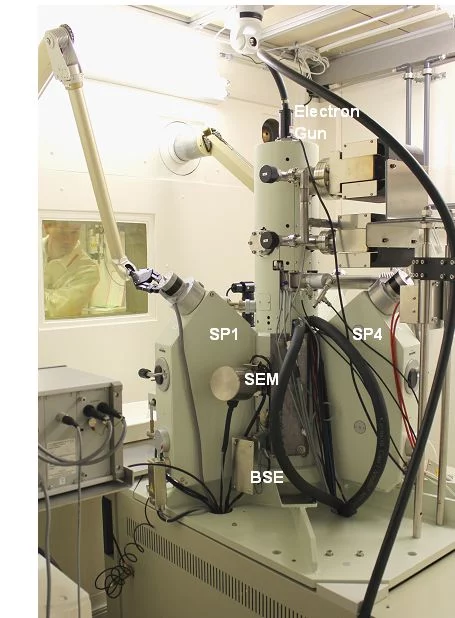Die EPMA ist ein Instrument zur hochauflösenden Oberflächenuntersuchung von festen Materialien und nutzt zwei Detektionsmethoden aus der Wechselwirkung eines hochenergetischen Elektronenstrahls mit der Probe – hochauflösende Oberflächenabbildung und quantitative Punktanalyse der Elementzusammensetzung.
Diese Methoden sind wie folgt spezifiziert:
Rasterelektronenmikroskopie (REM)
- Oberflächenabtastung mit einem Elektronenstrahl und Detektion von Sekundärelektronen (fotografisches Elektronenbild der Oberfläche).
- Darstellung der Topographie und Morphologie von Proben mit einer Vergrößerung von 40- bis 100.000-fach bei großer Tiefenschärfe.
- Rückstreuelektronendetektor (BSE) für den kontrastreichen Phasenvergleich der Zusammensetzung.
Röntgen-Mikroanalyse mit wellenlängendispersiver Spektroskopie (WDS)
- Quantitative Elementaranalyse von polierten Oberflächen in einem Mikrobereich von typischerweise 0,2 bis 2 µm³ bis zu Elementkonzentrationen von 0,1 Gewichtsprozent (Nachweisgrenze etwa 100 ppm) durch Messung der Emission von Röntgenstrahlen aus dem angeregten Zustand der Atome.
- Analysebereiche bis zu einem Durchmesser von 60 µm durch Defokussierung des Strahls.
- Elementverteilungsmapping von Oberflächen durch Strahl- und Bühnenabtastung.
Instrument
- JEOL 8500F mit Feldemissionskanone (FEG) mit hoher Helligkeit und kleinem Elektronenstrahldurchmesser.
- Hochenergetischer Elektronenstrahl (1–30 keV) und Stromstärken von 0,01 – 500 nA.
- Das Instrument befindet sich in einer bleigeschirmten Kabine, getrennt von der Steuerkonsole.
- Massive interne Wolframabschirmung zum Schutz der Röntgenzähl-Detektoren, um auch hochradioaktive Proben messen zu können.
- Vier Röntgenspektrometer (SP1 – SP4), zwei mit PET/LIF-Analysenkristallen, LD1/TAP und LD2/TAP für leichte Elemente.
- Zwei Probenträger für Proben bis zu einer Größe von 1¼-Zoll: ein geschirmter Halter für quantitative Analysen und ein Halter für die Kipp- und Rotationsbühne (z. B. für Bruchflächenuntersuchungen).
Anwendungsbereich
- REM- und BSE-mikroskopische Abbildung von Oberflächen.
- Quantitative Elementanalyse durch Röntgenstrahlen (Punktanalyse, Linienanalyse).
- Qualitatives und semi-quantitatives Elementmapping mit hoher Vergrößerung (lokale Strahlabtastung) oder großflächiger Bühnenabtastung (bis zu 20 x 20 mm²).

